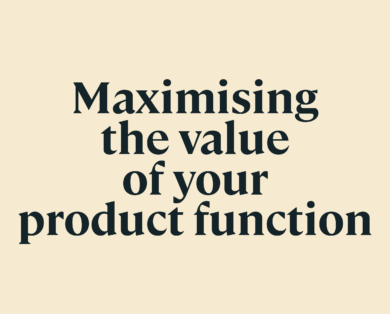- 24 July, 2024
This October, we hosted a seminar on how to achieve Conscious Inclusion within startups. While our sessions are usually exclusively for the portfolio, given the importance of the topic, this session was open to the wider community.
This has been the year of transformation – workplaces and work habits have been thoroughly transformed. With a major shift in cultural awareness, we find companies and their leaders wanting to enact real change and ensure their companies are truly inclusive workplaces.
The team leading this workshop – Manuel Wachter and Kim Gieske of EqualPlus Consulting – has a wealth of experience on the matter.
Kim drew on her experience as HR Director of Planet Organic Ltd, a UK health retailer, to explain how to improve diversity within organisations, and Manuel offered best practices from the latest research on inclusion at work.
The workshop focused on a direct seven-step approach to fostering a sense of shared belonging and high performance in a startup, even before there is a dedicated People team.
Here, we take a look back over the steps.
The Seven Steps:
- Look at the data first
- Embed a more inclusive culture
- Rethink talent acquisition
- Align training
- Strengthen employee relations
- Increase motivation & morale
- Refine compensation & benefits
1) Look at the data first
It’s always important to begin by taking stock of where you are and what is actually happening in the business. Here, both qualitative and quantitative data are essential. Examples would include measuring structural gaps as qualitative data or running an analysis on your employee retention rates.
Consider these questions when collating data:
- What is the organisational context?
- Have I set up a focus group to assess employee development?
- Have I sent out a company bespoke employee attitude survey?
- How fair are benefits and compensations across the firm?
Make an effort to speak to everyone in the organisation (size dependent) to dispel any assumptions you may have when collecting your data.
This is a great first step to advancing diversity, inclusion and belonging. However, data becomes irrelevant if nothing is done with it. If you’re going to do something useful with this data, you will need a dedicated budget. Too many organisations attempt to address issues with a limited budget, which normally goes to one-off training.
Looking at the data helps identify how your budget will tackle the specific barriers to inclusion in your company. It will also aid in prioritising which barrier to tackle first and help to assess success after you introduce interventions, such as training, coaching or refitting your processes. Being data-driven allows your firm to always have a baseline to return to.
Being data-driven is key – what gets measured gets reported; what gets reported gets done.
Gathering this information will enable you to put a microscope over the gaps in your company and start to move on to step two.
Different jurisdictions have different laws around what diversity data is legal and can be recorded. Make sure your efforts are within the law.
Manuel Wachter EqualPlus
2) Embed a more inclusive culture
What kind of culture are you building within your organisation? Do your values promote and support the creation of an inclusive culture?
Have a starting point when assessing how inclusive your company culture is. That starting point should be your company values.
Again, ask yourself these questions:
- Am I actively ensuring my employees feel safe and welcome working in my company?
- Do I have an enforceable equal opportunity policy that allows employees to go to their line managers to file discrimination complaints?
- Can my team have open and honest conversations about their choices?
- Does my team feel safe having open conversations about what they do and don’t know about diversity?
- Do I have a culture of explaining away discriminatory behaviour?
To be successful, you need a holistic approach to inclusivity. This translates to encompassing people management, company values, and employee behaviour.
Assessing your company culture will enable you to challenge the prevailing culture and acknowledge any systemic issues.
Shared Accountability – The purpose is to move to a culture where all employees are empowered to call out exclusionary behaviour and microaggressions. Create an entire ecosystem where multiple individuals, have responsibility for the matter, not just your People or D&I lead.
Leadership Culture – A significant part of an inclusive company culture is instilling this behaviour in senior leaders. Inclusive organizations will have leaders who use their power to support inclusion initiatives, rather than silencing or brushing them aside.
They set the tone for the business.
Line managers will actively include a set of diverse people in decision making and make sure that they have agency and influence in the day to day of the team environment.
Cultural changes only happen when there is a high level of communication taking place in the organization.
Awareness only takes us so far. To create sustainable, consistent, and measurable change in organizations it is imperative to dig deeper than cultural interventions – tackle the structural policies and practices of the company overall.
This is harder when you are a smaller company, or when you’re trying to enact change just within your team.
This simple exercise might help:
- If you are trying to decide as a team and you want to avoid groupthink, make sure you incorporate all perspectives before you make a final decision.
- If you have a team of five, bring six chairs for the meeting.
- Have a structured conversation where everyone has a chance to share their perspectives.
- When everyone has shared, “ask” the sixth empty chair their opinion by organizing a brainstorm about what perspective is missing in the team.
If it is noticed that the first five chairs are all men for example, or have a defining common identity, this may leave out other individualities that would be affected by the decision.
Whether they be colleagues, suppliers, or potential customers, being intentional about having a brainstorm around what may be their perspective on how they perceive the decisions being made in the room.
2) Rethink talent acquisition
A great way to build an inclusive culture is to make sure you’re fostering diversity and inclusion from the moment someone joins by rethinking your talent acquisition strategy.
Stay within the law – positive discrimination is illegal in many countries, and it’s not an “easy solution” to diversity problems.
One of the key pieces of information that will surface from collecting data (step 1) is informing where there is severe underrepresentation in your organisation.
It can never be said enough – make it a point to recruit, promote, and retain diverse leaders. Diversity culture is set from the top.
A few tips on how to “hack” talent acquisition:
- Make sure you always have a diverse shortlist of candidates for every role.
- Ensure your online presence promotes and displays the diversity in your company.
- Challenge the supply chain – look outside traditional pools of applicants.
- When recruiting recent graduates, look for which universities have the best programs related to the role, not just elite universities.
- Make a point to hire employees that can reflect your customer base.
- Consider non-graduate programs to tackle talent in diverse socioeconomic backgrounds.
- Remove names, universities, photos, or any other indicators of religion, ethnicity, etc.
It is incredibly important to remove biases from your pipeline and make sure you give every candidate a fair chance at a role.
4) Align training
Bespoke training should always be one part of your solution. Develop a coaching culture that supports your company’s aim to be inclusive. Make sure your leaders are onboarded into the company knowing that from the point on, they’ll be required to leave certain exclusionary views at the door.
Employers come from different backgrounds and cultures, and refining your onboarding process is a great way to make sure everyone knows certain behaviours are not part of the lived company values.
Be mindful of being tactful as to how this is done. Do not take training for granted:
- it helps to improve self-awareness – the first part of many diversity training is often 360-degree feedback.
- it’s a great tool for boosting the confidence of high-potential talents of diverse backgrounds who perhaps have experienced microaggressions.
- it starts to build a culture of trust and can enlighten and start to dismantle negative behaviours.
5) Strengthen employee relations
A signal your company’s commitment to inclusion legitimate is to not be tolerant of microaggressions between employees.
Microaggressions are subtle behaviours that let people know that they’re less valued or seeing through the lens of a stereotype. They can manifest as:
- friendly reminders not to eat smelly foods
- jokes about specific points of someone’s ethnicity, masculinity/femininity
- not recognizing someone because they’ve changed their hair
- touching someone’s hair
- consistently mispronouncing or misspelling someone’s name
The list can go on and on. These can become a real issue when normalised within the organisation. Each microaggression may not seem much, but the compound effect is extremely damaging. The word “Microaggression” should be normalized in the everyday language of your business.
Speaking up: create a speak-up culture that calls out racist behaviour or microaggressions. Openly racist behaviour is rarer than everyday microaggressions and can set a precedent of how colleagues relate to each other. The effect on the mental health, engagement, the productivity of the team can become significant when microaggressions are rampant in your company.
Developing employee confidence to deal openly with such issues, starts to move the culture of your organisation from a bystander to an upstanding one. That is where you want to be.
6) Increase motivation & morale
There is no better way to keep track of engagement than by surveying employee experience. And this can be done online or face to face, paying particular attention to the experience of minority employees.
There are many software solutions, such as Peakon, that can be incredibly effective in gathering this type of information. Remember, data collection is only step one. What you do with it on a regular basis, is what will create the changes you seek.
As a leader don’t shy away from highlighting negative experiences and quoting those back to the whole management team. These stories are very powerful and spur change. They begin to allow everyone to understand the obstacles and structures that minority employees can experience.
Employee Resource Groups can provide an avenue for employees to discuss issues they find difficult. They develop bridges and best practices through facilitated conversations about how to talk about race in the workplace. It is also another way to make sure the work on inclusion and belonging is not the sole burden of one leader.
Kim Gieske EqualPlus
7) Refine compensation and benefits
The pay gap in underrepresented groups is something that is encouraged to focus on. Develop reward schemes that reinforce inclusive behaviour, including non-monetary benefits.
Consider simple rewards for your company (size dependant):
- Child/childcare support
- Mental health benefits
- Health benefits
Monitoring the gaps in terms of promotions and retention is a great start to understanding what the barriers to a sense of shared belonging reside.
Making sure that internally, there is transparency on that data is a way to bring your team together.
Engagement and diversity and inclusion figures can look their absolute best, but transparency is the foundation for public accountability.
There is no one-size-fits-all all solution to tackle diversity and inclusion efforts. Figure out how you can best approach your specific case, company’s needs and develop a strategy and metrics to measure that make sense for your goals and targets. The results will undoubtedly be an organization that is inclusive and high-performing.
More on the team:
CEO and Founder, Manuel Wachter
Manu Wachter is a global expert in organizational diversity, belonging, and inclusive coaching. He combines expertise in operations management (JP Morgan), leadership development (World Economic Forum), and diversity & inclusion (Ecole Lacanienne de Psychanalyse, EDGE). He has two Masters in International Management (ESCP Europe, City University), an Executive Masters in Global Leadership (jointly delivered by Columbia, Wharton, LBS, INSEAD, and CEIBS), and two coaching accreditations from Best Year Yet (Denver, CO) and the Academy of Executive Coaching (London, UK).
HR Consultant, Kim Gieske, MA, MBA, FCIPD
Kim Gieske is a Strategic HR Consultant and Executive Coach. She has 25 years in HR. 10 years were spent working internationally as a Headhunter and 15 years were spent in senior HR roles working for luxury brands in retail and hospitality. She’s a Chartered Fellow of the CIPD, she has a Masters in Strategic Human Resource Management and an MBA.










